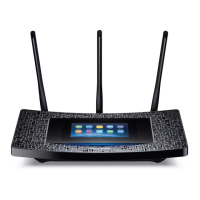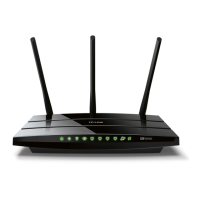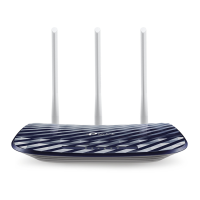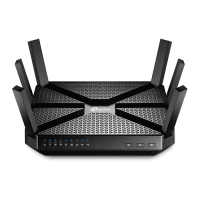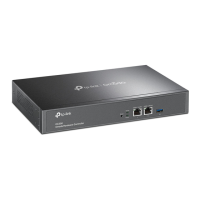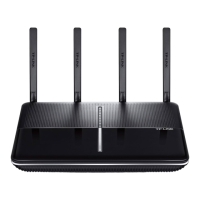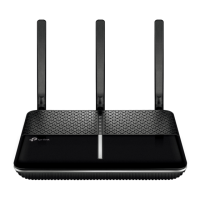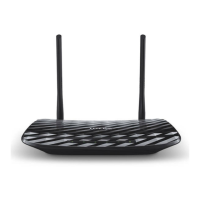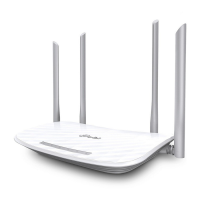
Do you have a question about the TP-Link AC1350 and is the answer not in the manual?
| Frequency Band | 2.4 GHz and 5 GHz |
|---|---|
| Antenna | 3x External Antennas |
| Wireless Security | 64/128-bit WEP, WPA/WPA2, WPA-PSK/WPA2-PSK |
| Wireless Standard | IEEE 802.11ac/n/a 5 GHz, IEEE 802.11b/g/n 2.4 GHz |
| Wi-Fi Speed | 867 Mbps at 5 GHz, 450 Mbps at 2.4 GHz |
| USB Port | 1 x USB 2.0 |
| Security Features | Access Control |
| Dimensions | 243 x 160.6 x 32.5 mm |
Describes the router's capabilities, features, and benefits for SOHO networks.
Details the front and back panel components, including LEDs and buttons, for status and operation.
Guides on optimal router placement and the steps to physically connect it to the modem and power.
Explains how to use the Wi-Fi Protected Setup (WPS) button for easy wireless device connection.
Instructions on how to access and log into the router's web management page for configuration.
Step-by-step guide for automated internet connection setup using the router's wizard.
Procedures for manually configuring various internet connection types like PPPoE, Static IP, etc.
Instructions for configuring the router to use IPv6 internet services provided by the ISP.
Steps for registering, changing, and managing TP-Link IDs for router access and cloud features.
How to install and use the Tether app for local and remote router management and monitoring.
Guides on setting up a separate Wi-Fi network for guests and configuring its security and access options.
Instructions for connecting USB storage, accessing files locally/remotely, and media/printer sharing.
How to block inappropriate websites and control internet access based on time and specific site lists.
Setting up Quality of Service rules to prioritize specific devices or applications for better network performance.
Configuring SPI Firewall and DoS Protection to safeguard the network from cyber threats.
Blocking or allowing specific devices to access the network using MAC address filtering.
Binding IP addresses to MAC addresses to prevent ARP spoofing and related attacks.
Setting up virtual servers to share internal services like websites or FTP servers on the internet.
Configuring port triggering for applications like online games that require dynamic port access.
Setting up a DMZ host for unrestricted bidirectional communication between internal and external hosts.
Enabling Universal Plug and Play (UPnP) for seamless connections in online gaming and other applications.
Configuring the router as an OpenVPN server for secure remote access to the home network.
Configuring the router as a PPTP VPN server for remote access, offering simpler setup.
Modifying the router's LAN IP address and subnet mask to avoid conflicts or customize the network.
Setting up the router to support Internet Protocol Television (IPTV) services from your ISP.
Configuring DHCP server settings, including IP address pools and reservations for client devices.
Setting up DDNS to access the router remotely using a domain name instead of an IP address.
Manually configuring routing entries to guide data packet forwarding to specific destinations.
Adjusting SSID, password, security options, transmission mode, and channel width for wireless networks.
Utilizing Wi-Fi Protected Setup (WPS) for easy and secure Wi-Fi connections using PIN or push button.
Setting the router's system time for accurate time-based functions like Parental Controls.
Managing router LED behavior and enabling a night mode to turn them off during specific periods.
Testing network connectivity using Ping and Traceroute tools to identify issues.
Steps for performing online and manual firmware upgrades to maintain router functionality.
Backing up and restoring router settings, including factory default resets for troubleshooting.
Changing the admin password and setting up password recovery for secure router access.
Configuring access controls for managing the router from the local network or remotely.
Viewing system logs for troubleshooting and monitoring internet traffic statistics.
Steps to retrieve or reset a forgotten wireless network password.
Troubleshooting steps for forgotten web management passwords and login problems.
How to configure WDS bridging to extend wireless network coverage using an additional router.
Solutions for common internet access issues like no connection, DNS problems, or MAC address conflicts.
Steps to resolve issues with finding or connecting to the wireless network, including driver and signal problems.

